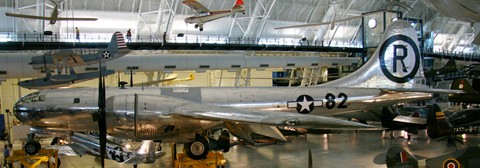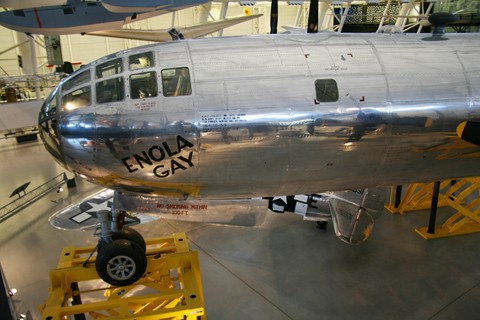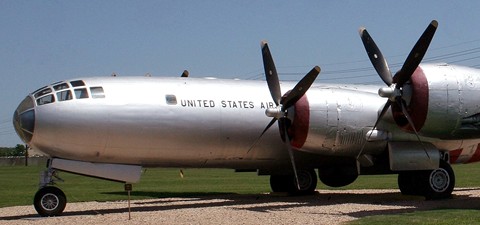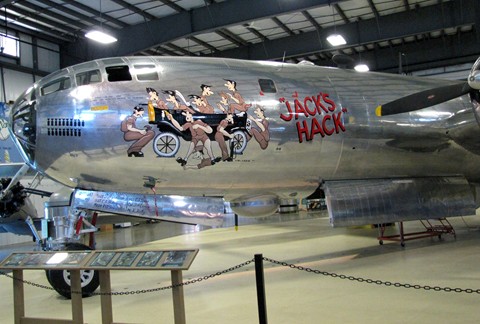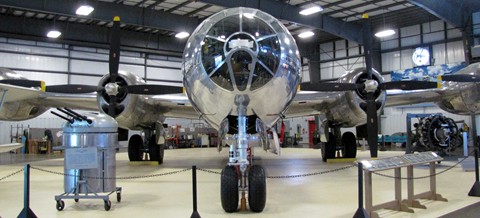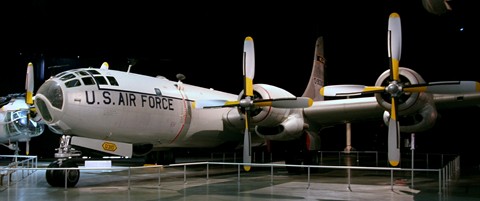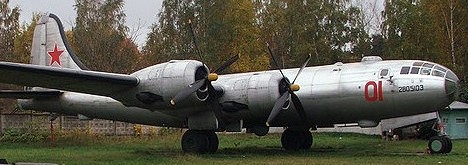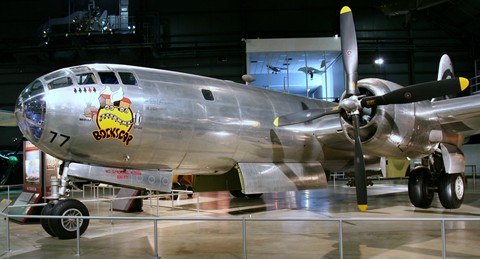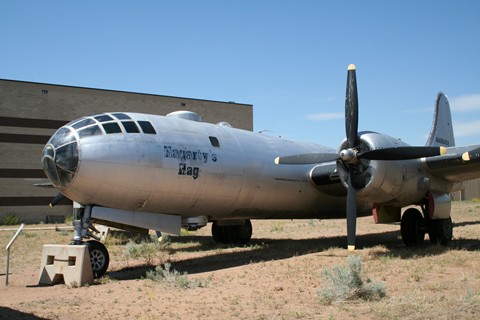|
B-29 SuperfortressThe B-29 Superfortress was a four engine WWII bomber with advanced features like pressurized crew compartments, remote control machine gun turrets, and an electronic fire control system. Its advanced features and rush into production came at a price with countless production problems including its Wright R-3350 engine. The first prototype crashed, killing its 10 man crew and 20 civilians in a meat packing plant. Despite its many setbacks, the B-29 was successful in World War II flying at great distances (3,250 mile combat range) and at high altitudes (33,600 feet) to deliver its 20,000 pound payload. The most famous B-29 is the Enola Gay (44-86292) which dropped the first atomic bomb on Hiroshima, Japan. This aircraft is on display at the Udvar-Hazy Center which is a branch of the Smithsonian Institute's National Air and Space Museum. Photos below of the Enola Gay taken by Horace Sagnor.
BeginningsOn November 10, 1939, General Henry 'Hap' Arnold, Chief of the Air Corps, requested the War Department initiate development of a four engine heavy bomber. His request was granted and Request for Data R-40B was sent to major aircraft manufacturers. Arnold's requirements called for a range of 5,333 miles with a ton of bombs. It so happened that Boeing was already designing such an aircraft dubbed the Model 341. On the strength of its data and the initial success of the B-17 Flying Fortress, Boeing won a contract on September 6, 1940 to produce two XB-29 prototype aircraft. A third prototype was added to the order in November.
Photo above shows an unnamed B-29 (44-87627) that is based at the Eighth Air Force Museum at Barksdale AFB, Bossier City, LA. The aircraft has no name as it was once a TB-29, trainer version of the B-29. World War II ServiceThe intended use of Superfortresses in WWII was to bomb Japan, but the first B-29 was deployed to England in March 1944. It was sent to the European theater to trick the Germans into thinking that B-29s were to be based in England, and to disguise the concentrated use of Superfortresses against Japan. Initial bombing of Japanese territory began in June 1944 from bases in China and India. When resupplying these bases proved difficult, the aircraft's base of operations shifted to the newly captured Mariana Islands in October 1944. it was easier to resupply by ship than fly supplies over the 'hump' (Himalayas). Five bases with four bomb groups each were based on Tinian (three airfields), Guam, and Saipan. From the Marianas, the US dropped 177,000 tons of bombs on Japanese islands. With bad weather frequently hampering precision bombing, a switch to night incendiary attacks began. These attacks crippled Japan long before the dropping of the two atom bombs on Hiroshima and Nagasaki. Japan's combat casualties for the entire war were 780,000. In nine months of bombing by this Boeing heavy bomber, civilian casualties in Japan were 806,000 including 330,000 dead. No single aircraft in the history of mankind has inflicted so much destruction in such a short amount of time.
The photo above is a B-29A (44-61566) housed at the New England Air Museum. There is very little difference between Superfortress models. Korean WarIn the Korean War the Superfortress was used initially for strategic daytime bombing, but with the advent of the jet-powered Mig-15, a switch was made to night bombing only. The Soviet Mig-15 was specifically designed to shoot down the Superfortress. With the advent of jet power, the B-29's fate was sealed. The Boeing B-47 Stratojet replaced the Superfortress, and later the B-52 Stratofortress became the standard Air Force bomber. On June 21, 1960, the last Superfortress was retired. VariantsWB-29: Weather reconnaisance version.
Another variant was not American made. It was the Russian made Tupolev Tu-4, copied from a Superfortress named 'Ramp Tramp' (42-6256). Ramp Tramp was forced to make an emergency landing in Russia on its way back from a bombing mission in Manchuria. The Russian Air Force interred the crew and kept the aircraft. Tu-4 photo below courtesy of Pavel Adzhigildaev.
More Survivors
Of the 3,970 Superfortresses built, 26 are known to exist. Besides those already shown, 'Bockscar' (44-27297) is on display at the National Museum of the United States Air Force in Dayton, Ohio. This aircraft (see photo above) dropped the atomic bomb on Nagasaki, Japan. One Superfortress, 'Fifi' (44-62070), remains airworthy with the Commemorative Air Force in Midland, TX. It is currently undergoing an expensive engine overhaul. Just can't get rid of those engine problems. Funds were being gathered for the B-Superfortress 'Doc' (44-69972) to become airworthy. Funds ran out, however, and the plane is currently stored inside at the Kansas Aviation Museum in Wichita, KS. Doc served in the Korean War and was built at the Boeing plant in Wichita.
'Haggerty's Hag' (44-86408) is on display at the Hill Aerospace Museum in Ogden, Utah. See photo above. Navigation IndexReturn to the top of this B-29 page.
|
